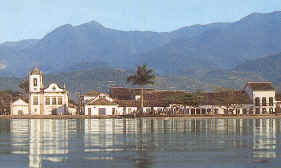

Destinations
Experiences
 |
L A
D A T C O T O U R
S |
 |
||||||||
| HOME | South America | Falkland Islands | Antarctica | Unique Destinations |
Unique Experiences |
Newsstand | ||||
 Parati |
Rio de Janeiro Around & About
|
Just 40 miles from Rio is Petropolis, former home of the last emperor of Brazil, Pedro II. It was envisioned as a refreshing refuge from the simmering Rio heat, and remains today a popular getaway spot.
The road to get to Petropolis is well worth the drive, climbing some 2750 feet from sea level into the mountain range in little over an hour's driving time.
The Imperial Museum was the former royal Summer Palace and today houses the crown jewels, a glistening frame of 77 pearls and 639 diamonds. There is period furniture and many photographs as well as the colorful ceremonial wardrobe of the emperor.
Another mountain getaway gem is Teresopolis, 53 miles from Rio at the end of the Rio-Teresopolis Highway, a small town of just 130,000.
Besides visiting the cool Serra Fluminense towns of Petropolis and Teresopolis, you can spend a relaxing day on a schooner, sailing from Itacuruca, 40 miles south of Rio. The schooners hold up to 40 persons and they spend the day cruising the tropical islands in the Baia de Sepetiba. It's a lazy day of samba music, cool "caipirinhas" and "batidas", secluded beaches, crystal clear waters and beach picnic.
To the north of Rio is Buzios, a destination in itself and the "jet set" resort of Brasil, made famous when photographers snapped pictures of Brigit Bardot walking along one of the beaches there.
And to the south are two places of interest:
Angra dos Reis, 92 miles south of Rio, said to have been founded in 1502,
is situated on a large bay filled with 370 islands, seven bays, dozens of coves and some
2000 beaches. Angra is one of the more sophisticated resort village. Hotel do Frade is a
good resort style hotel with direct access to the beach and with a 18 hole golf course.
Further south is Parati, a small colonial jewel protected from the modern world due to lack of a road to get to the town. It was declared a national monument by UNESCO in 1966. Founded in 1660, it was the main port for shipping gold and diamonds from the state of Mineas Gerais to Rio or directly to Portugal. There is a remarkably well preserved historic center, with colorfully painted doors and windows, many art galleries, handicraft shops, colonial houses and quaint pousadas where you can overnight. The reason to come is to explore the colonial center of town but you can also do a schooner cruise into the bay and visit a fazenda for a peek into the life ways of the past.